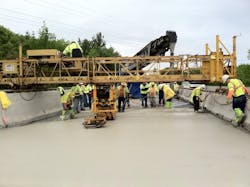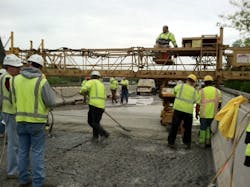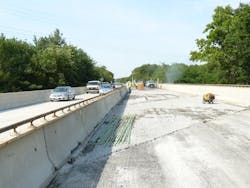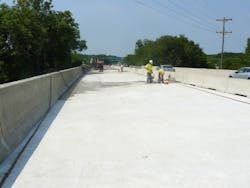Concrete is a primary construction material for hundreds of thousands of bridges and bridge decks throughout the U.S. As state DOTs look to preserve rather than replace these bridges, construction firms must evaluate performance, budget, and time constraints to determine the best concrete materials for each project.
One of the most common types, portland cement concrete, is suitable for many projects and applications, but is limited by its week-long cure time, says Chris Davis, eastern regional manager of engineering sales for CTS Cement. A product like CTS’s Rapid Set latex-modified concrete (RSLMC) mix cuts that curing time down from days to mere hours. RSLMC is used for projects like bridge deck overlays, elevated deck repairs, and pavement repairs, and is ready for traffic in three to four hours.
“If you use Rapid Set cement with latex in the mix, it becomes VES, very early strength,” Davis said. “You can reopen the bridge in three hours, where the standard cement takes a week.”
CTS has seen an uptick in sales of another product, called Low-P. It is a polymer-modified cement in which contractors do not have to add the liquid latex. “But you get all the features of it,” Davis said. Low-P has long-life durability and freeze-thaw resistance, and is ready for traffic in three hours.
Whether states use RSLMC material depends on a variety of factors, including budget, location, and traffic congestion.
“Low-P and RSLMC are more expensive, but you offset those costs by opening up the bridge much quicker. The small additional cost of the materials is more than offset by the savings created by much shorter closure times,” Davis said.
CTS has completed a number of bridge overlay projects in the past years, including a project on Route 95 in Foxboro, Massachusetts to repair bridges that were about 50 years old. Contractors milled the bridge overlays then applied the Low-P product.
“They were able to do two lanes on two or three bridges over one weekend, and then do the other two lanes,” Davis said. “There was no real disruption to weekday traffic, and now they don’t expect to go back to those bridges for another 25 years.”
Low-P does not need the extra or special equipment required to add latex to common concrete, he added.
“That typically brings the cost down because more people can do it,” Davis said. “You need special equipment for the liquid latex trucks and an extra fluid system.” Not every DOT will have that equipment, he added.
In addition to faster turnaround time, Davis said an advantage of Low-P is the very low permeability of the materials. Water and road salt intrusion can corrode a bridge’s steel reinforcement. “Water and salt can’t permeate the bridge overlay deck,” he said. With the Low-P, “it’s like waterproofing a deck. It preserves those decks.”



